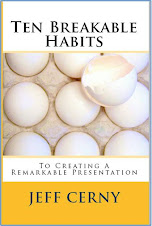
Mark Egan, whose company VMware is synonymous with trailblazing and dominating the area of virtualization, recently talked with me about his perspectives on the future of real technology in a virtualized world.
"...if you think of social-media apps, for example, how do we take some of these systems with a Soviet-era interface and make them look like Facebook and be as easy as Twitter? I believe the user interface trumps functionality."
Another insight from Mark was on his top recommendation for making a more remarkable business presentation.
"I always like to see a speaker who keeps the focus on the question, 'What is the business problem we're trying to solve?' and ultimately answers it. In my humble opinion, as a CIO I should always be focusing on three areas for the company: growing revenue, reducing costs and improving customer satisfaction. Everything I do should track back to those three. Sometimes in our presentations I think we lose the translation to those areas. Those are the things I think we need to see made relevant, and in some cases I've seen my peer presenters get sidetracked to other things."
You can find the entire discussion with Mark in the article out today at CBS Interactive.














